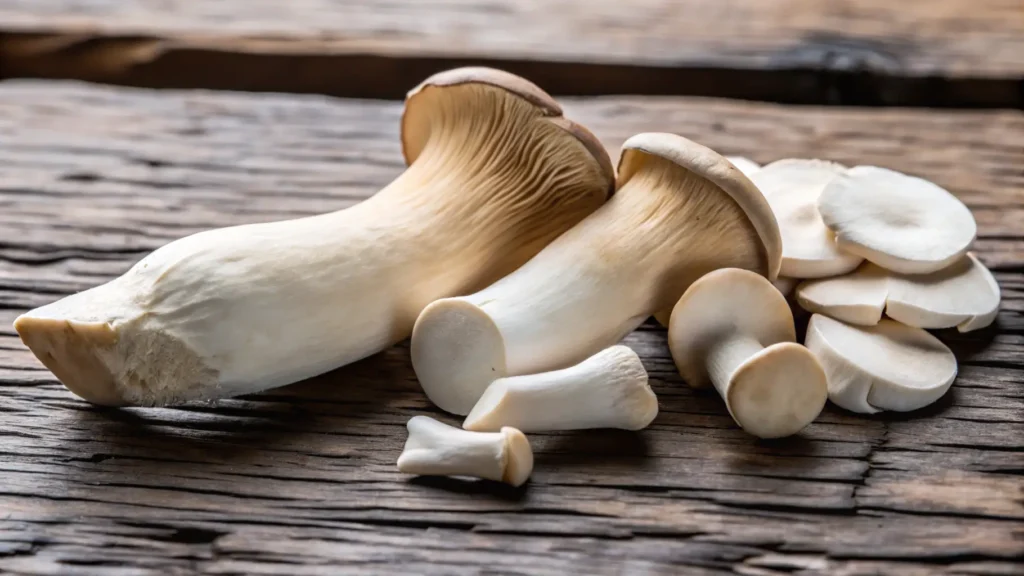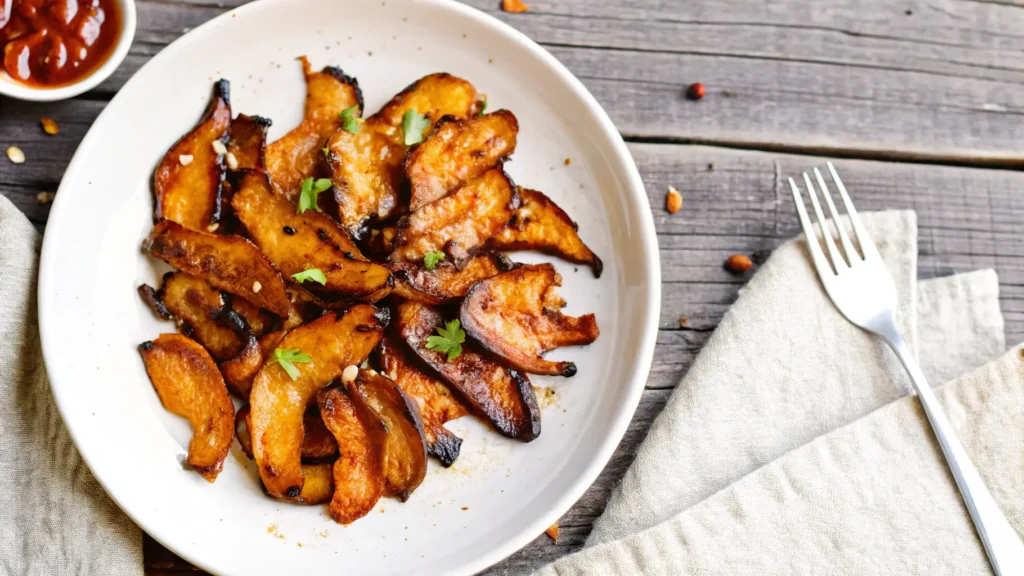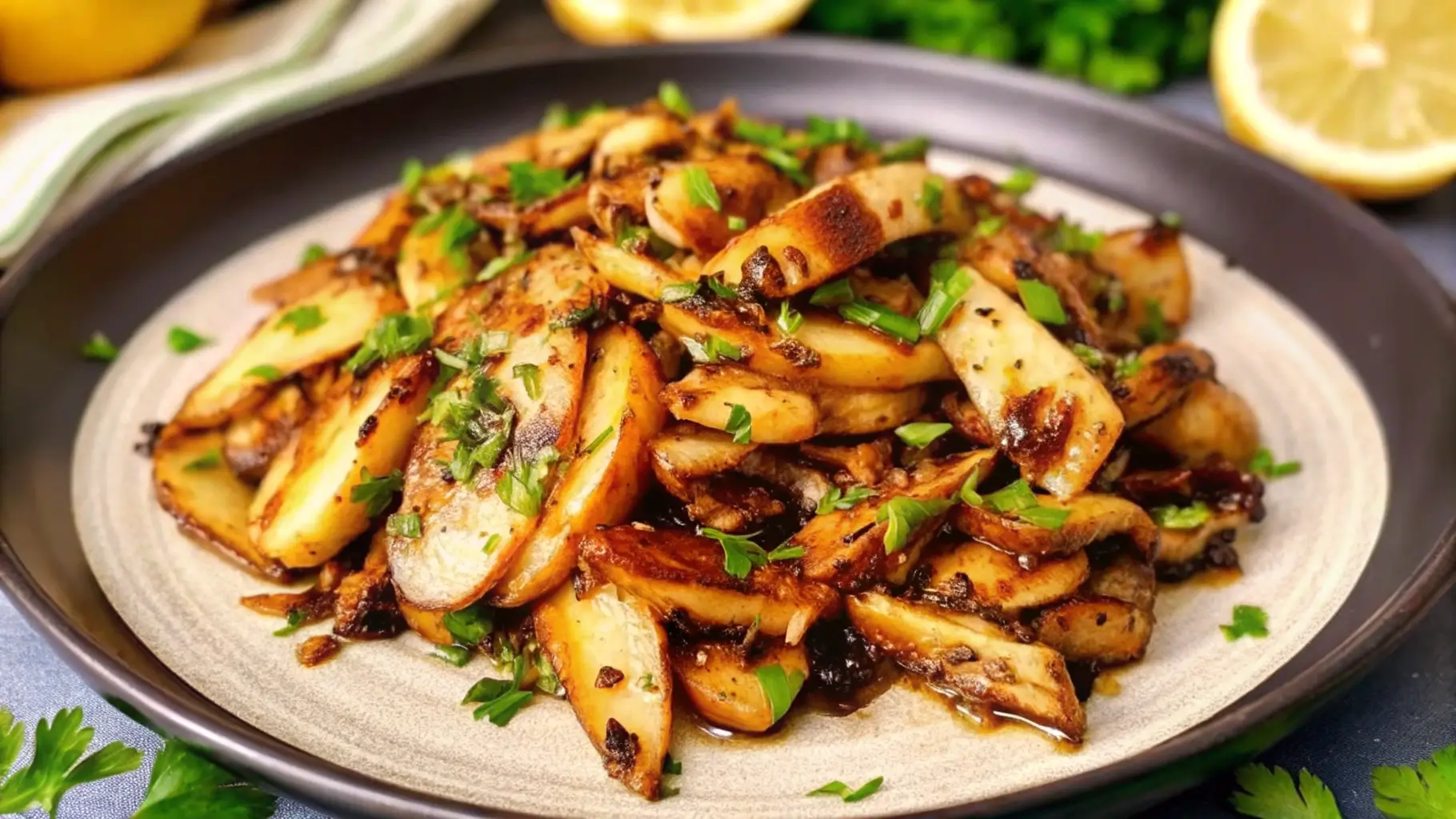Reading time: 11 minutes
The first time I saw a trumpet mushroom, I wasn’t sure how to prepare it. Was the stem too tough? Should I only use the cap? These questions led me to research everything about this unique mushroom. If you’ve ever wondered what part of trumpet mushroom is edible, you’re not alone. Many people hesitate before cooking it, unsure if they’re using it correctly. Today, I’ll walk you through each part of the mushroom, how to use it in cooking, and the best ways to prepare it for the richest flavor.
Table of contents
- How to Identify Edible Sections of King Trumpet Mushrooms
- Exploring the Culinary Uses of Black Trumpet Mushroom Parts
- Comparing Edible Parts of King Trumpet and Black Trumpet Mushrooms
- Step-by-Step Guide: Preparing Edible Parts of Trumpet Mushrooms
- Nutritional Benefits of Consuming Different Parts of Trumpet Mushrooms
- Common Misconceptions About Edible Parts of Trumpet Mushrooms
- Safety Tips for Consuming Various Parts of Trumpet Mushrooms
- Expert Insights: Chefs Discuss Edible Parts of Trumpet Mushrooms
- FAQs
- Conclusion
How to Identify Edible Sections of King Trumpet Mushrooms
King trumpet mushrooms stand out for their thick, meaty stems and small, rounded caps, making them one of the most versatile mushrooms in the kitchen. Unlike many other varieties, the cap is typically the main edible portion of mushrooms. The stems are often discarded. However, the king trumpet mushroom is different. Both the cap and the stem are fully usable, making it a favorite among chefs and home cooks. It’s especially popular for those looking for a plant-based ingredient that mimics the texture of meat or seafood.
Each part of the king trumpet mushroom has unique characteristics that make it ideal for different cooking methods:
- Cap: Soft and tender, this part absorbs flavors exceptionally well. It works beautifully in stir-fries, sautés, and pasta dishes, where it develops a slightly chewy, yet delicate texture.
- Stem: The most substantial part of the mushroom, the stem has a dense, almost fibrous consistency that holds up well to high-heat cooking. Many chefs slice it into thick rounds and sear it like scallops, while others grill or roast it for a satisfying bite.
- Base: Although the bottom part of the stem can be slightly tougher, it is still full of umami-rich flavor. Instead of discarding it, I like to use it in broths, stocks, or blended into sauces to add depth.
What makes king trumpet mushrooms truly special is that their stems are just as valuable as their caps. While some mushrooms, like shiitakes, have woody, inedible stems that must be removed, the king trumpet offers a full-bodied texture and flavor throughout. With the right preparation, every part of this mushroom can be transformed into a delicious ingredient, ensuring nothing goes to waste.
Exploring the Culinary Uses of Black Trumpet Mushroom Parts
The black trumpet mushroom has a different texture from the king trumpet, but its entire body is edible. With its delicate, funnel-like shape, the black trumpet lacks the thick stem of its cousin. Instead, it offers a rich, earthy flavor that enhances many dishes.
Here’s how I use different parts:
- Whole Mushroom: Since black trumpets are thin and hollow, the entire mushroom works well in recipes.
- Dried and Crushed: I often dry them and grind them into powder for seasoning soups and sauces.
- Sautéed: Their deep umami taste pairs well with butter, garlic, and fresh herbs.
Because they’re more fragile than king trumpet mushrooms, black trumpets need gentle handling, but every piece is packed with flavor.

Comparing Edible Parts of King Trumpet and Black Trumpet Mushrooms
Both king trumpet and black trumpet mushrooms are completely edible, but their textures and culinary uses vary greatly, making each one suited to different cooking needs and flavor profiles.
- King Trumpet: Known for its firm, dense texture, the king trumpet mushroom holds up wonderfully to heat. Its meat-like consistency makes it ideal for grilling, roasting, or slicing into thick pieces. Whether I’m making a savory stir-fry, grilling it for a BBQ, or adding it to a hearty vegetable roast, this mushroom provides a satisfying, chewy bite. Its versatility is unmatched, allowing it to easily take on the flavors of any dish it’s included in.
- Black Trumpet: On the other hand, black trumpet mushrooms are thin and fragile, but they pack an intensely earthy, almost smoky flavor. Their delicate structure makes them perfect for sautéing, where they soften and absorb the surrounding seasonings. They also dry well, intensifying their flavor, and are often used as a seasoning or in risottos, soups, and sauces for that deep, rich umami punch.
When deciding between the two, I always consider the dish I’m preparing. If I want a chewy, satisfying bite that can stand up to grilling or roasting, king trumpet mushrooms are my go-to. But if I’m looking to add a complex, earthy depth to my dish, especially in soups or sauces, black trumpet mushrooms are the ones I reach for. Each mushroom brings something unique to the table, and by keeping both on hand, I’m ready to elevate any meal.
Step-by-Step Guide: Preparing Edible Parts of Trumpet Mushrooms
Cooking mushrooms the right way can really elevate their flavor and texture, transforming an ordinary dish into something special. Here’s how I approach preparing king trumpet and black trumpet mushrooms for the best results:
- Cleaning: Mushrooms are like little sponges, soaking up moisture, so soaking them in water is a no-go. Instead, I always wipe them gently with a damp cloth to remove any dirt or debris. For more stubborn dirt, I use a soft brush to clean the crevices without damaging the delicate caps or stems. This ensures that the mushrooms stay fresh and retain their perfect texture.
- Trimming: When it comes to king trumpet mushrooms, I trim the very bottom of the stem if it feels dry or tough. This part can sometimes be a little fibrous, so removing it makes the rest of the mushroom more tender and enjoyable to eat. The rest of the stem, however, is great for cooking and can be used just like any other part.
- Slicing: For grilling or roasting, I love to cut thick slices of the stem, which helps it hold up well to heat and ensures a satisfying bite. The stems are dense and meaty, making them perfect for high-heat cooking methods. If I want a more delicate texture, especially for sautéing or stir-frying, I chop the caps into smaller, bite-sized pieces, allowing them to absorb the flavors of the dish and cook quickly.
Cooking:
- King trumpets develop a deep, rich flavor when roasted or grilled. The heat brings out their natural umami, giving them a meaty texture and savory taste that works perfectly as a main dish or a side. I love to grill them with a bit of olive oil, salt, and pepper, letting the natural sweetness caramelize.
- Black trumpet mushrooms shine in buttery sautés or as a garnish for pasta and soups. Their thin, fragile texture makes them perfect for quick cooking methods that preserve their delicate nature, and their intense, earthy flavor adds an incredible depth to any dish. I sauté them with butter, garlic, and herbs, allowing them to absorb the richness while keeping their unique, smoky flavor intact.
By following these simple steps, I make sure I’m getting the most out of every piece of these delicious mushrooms, bringing out their full potential in every bite. Whether grilling, roasting, or sautéing, the right preparation makes all the difference in creating a flavorful, satisfying dish.

Nutritional Benefits of Consuming Different Parts of Trumpet Mushrooms
When I first started eating trumpet mushrooms, I wasn’t just drawn to their flavor—I wanted to know if they were healthy too. It turns out that both king trumpet and black trumpet mushrooms are packed with nutrients.
Here’s what makes them a great addition to any meal:
- Rich in Protein: The king trumpet’s meaty stem contains a good amount of plant-based protein, making it a great option for muscle repair and energy.
- Loaded with Antioxidants: Black trumpet mushrooms have high levels of antioxidants, which help protect the body from damage caused by free radicals.
- Supports Immune Health: Both varieties contain beta-glucans, which can boost the immune system and improve overall health.
- Low in Calories, High in Fiber: These mushrooms are filling without adding extra calories, making them perfect for balanced eating.
By including all edible parts, I get the full range of benefits from these mushrooms without any waste.
Common Misconceptions About Edible Parts of Trumpet Mushrooms
I’ve heard a lot of myths about trumpet mushrooms, and I used to believe some of them myself. Here are the most common ones—and the truth behind them.
- “Only the cap is edible.” In reality, the entire mushroom can be used. The king trumpet’s stem is just as valuable as the cap.
- “Trumpet mushrooms taste better raw.” While they are technically safe to eat raw, cooking them enhances their flavor. It also improves digestion.
- “The base of the king trumpet should always be thrown away.” The bottom part can be tough, but it’s perfect for soups and stocks.
- “Black trumpet mushrooms are poisonous if eaten in large amounts.” These mushrooms are completely safe. However, they should be cleaned properly to remove dirt and debris.
Once I learned the facts, I stopped wasting perfectly good mushroom parts and started making the most of every piece.
Safety Tips for Consuming Various Parts of Trumpet Mushrooms
Mushrooms are delicious, but knowing how to handle them safely is just as important as knowing how to cook them.
Here are some tips I always follow:
- Buy from trusted sources: Whether fresh or dried, I make sure my mushrooms come from a reliable seller to avoid contamination.
- Clean them properly: I never soak them in water, as mushrooms absorb moisture quickly. Instead, I wipe them with a damp cloth or brush off any dirt.
- Cook thoroughly: Cooking mushrooms helps break down compounds that might be harder to digest when raw.
- Store correctly: Fresh mushrooms last longer when kept in a paper bag in the fridge, while dried ones should be stored in an airtight container.
By following these steps, I make sure that every part of my trumpet mushrooms is safe to eat and full of flavor.

Expert Insights: Chefs Discuss Edible Parts of Trumpet Mushrooms
I love learning from professional chefs, so I asked a few what they think about trumpet mushrooms. Their answers confirmed what I already believed—every part of these mushrooms is worth using.
- Chef Amie, a fine-dining expert: “King trumpet mushrooms are one of my favorite ingredients. I use the stems in place of scallops, and the caps make excellent toppings for gourmet pizzas.”
- Chef Karl, a mushroom specialist: “People throw away the base of king trumpets far too often. I save them for stocks, and the depth of flavor they add is incredible.”
- Chef Linda, a plant-based cook: “Black trumpet mushrooms are a hidden gem. I dry them, grind them into powder, and use them as a natural seasoning. It makes every dish taste richer.”
After hearing their insights, I became even more committed to using every part of my mushrooms in creative ways.
FAQs
Yes, you can eat the whole king trumpet mushroom! Unlike many other mushrooms where only the cap is commonly consumed, the king trumpet is fully edible from top to bottom. The stem is dense and meaty, making it just as valuable as the cap. Simply trim the bottom if it feels dry or tough, and the rest of the mushroom can be grilled, roasted, or sautéed to perfection.
No, king trumpet mushrooms and oyster mushrooms are different species, though they do share some similarities. Both belong to the same family (Pleurotaceae), but they differ in size, shape, and texture. King trumpet mushrooms are larger, with a thick, meaty stem and a small cap. In contrast, oyster mushrooms are more delicate. They have a softer texture and a broader cap. Their flavors differ as well. King trumpets offer a savory, umami-rich taste. Oyster mushrooms provide a milder, more delicate flavor.
Yes, king trumpet mushrooms are completely edible. Every part of the mushroom, from the cap to the stem, is usable in cooking. The stem, which is dense and meaty, is particularly prized for its texture, while the cap is tender and perfect for dishes like stir-fries, pasta, and sautés.
King trumpet mushrooms have a rich, savory, and meaty flavor that is often described as umami-packed. The taste is hearty and satisfying, especially in grilled or roasted preparations, where it develops deeper, more caramelized notes. The texture of the stem is dense and chewy, which adds to the overall meaty experience, making it an excellent alternative to meat in vegetarian and vegan dishes.
Conclusion
So, what part of trumpet mushroom is edible? The answer is simple—every part. From the cap to the stem and even the base, trumpet mushrooms offer endless possibilities in the kitchen. Whether grilled, sautéed, dried, or added to soups, they bring unique textures and flavors to any dish.
Now that I understand how to prepare them properly, I never waste a single piece. By using the full mushroom, I get the best taste, maximum nutrition, and the satisfaction of making the most of this incredible ingredient.
Explore more related topics here:

